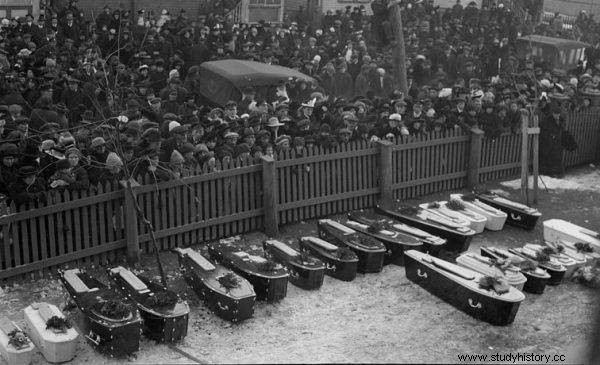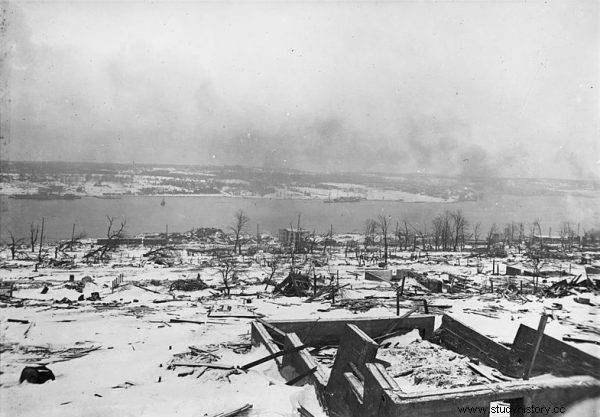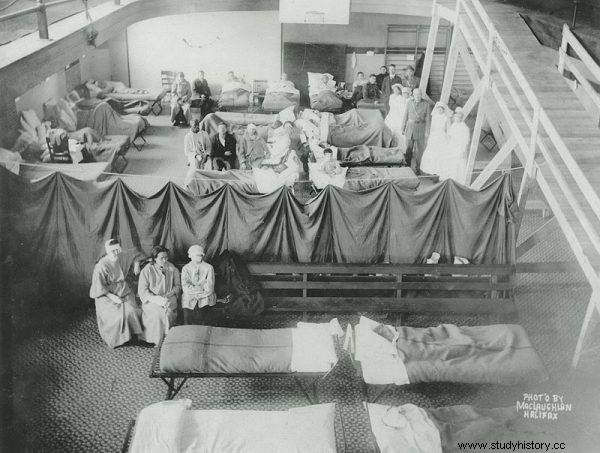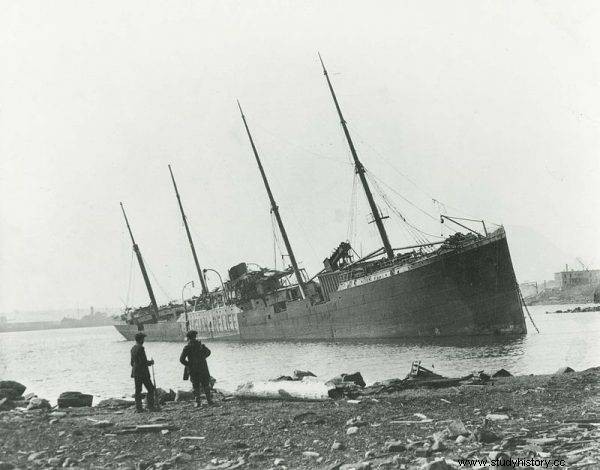On December 6, 1917, two ships collided in the port of Halifax. The gigantic explosion that resulted from the accident killed nearly 2,000 people.
Stop the train. The ship with the ammunition caught fire in the port, is headed for pier 6 and is about to explode. I think this will be my last message. Goodbye boys, said Vincent Coleman, Halifax train dispatcher and silent hero of one of the greatest maritime disasters in history.
When on December 6, 1917, before At 9.00, Coleman learned that the ship on fire was explosives and ordered his employees to leave the railway station near the port. He himself started to run away. After a while, however, he remembered that a passenger train was due to arrive in the city at 8.55. Ignoring the danger, he returned to the duty room and sent an alarming message to the staff of the depot. Moments later the sky above Halifax was torn apart by the roar of a terrifying explosion. The telegram received just before the explosion saved 300 passengers of the train . Unfortunately, the heroic railwayman and nearly 2,000 were less fortunate. residents of Halifax.
Rally point
In December 1917, the conflagration of the Great War seemed to be heading towards the final decisions. The parties to the conflict performed miracles of bravery and determination. At the same time, the exhaustion of the material war reached its zenith, especially when the United States joined the struggle with the Central Powers.

Collective funeral of the victims of the Halifax disaster
Among North American ports, Canadian Halifax was then one of the main transhipment and assembly points for convoys with supplies for the Entente forces. Thus, the hitherto peaceful city, known for the burial of the greatest number of Titanic victims, became overnight the bustling logistics center of the Allies. It is assumed that the pre-war population of 40,000 in Halifax increased by 1/3, and the value of goods passing through the port increased ninefold. At the same time, ships filled with wounded soldiers and civilian refugees from fighting areas were arriving from bloodied Europe.
Playing with fire
The traffic in the port's waters was so great that it often took place in violation of safety rules. Especially in special cases it was very risky. As the researcher of the subject Michał Banach notices:
Before the war, due to the dense buildings and the small distance separating the city buildings from the quays, ships carrying dangerous goods could not enter the port without adequate protection in the form of a pilot and a guiding unit . Additionally, such ships could not wait for unloading in the harbor bay and had to wait outside the bay for their turn.

Destruction in Halifax after the explosion
However, during the war, these rules were relaxed in fear of German submarines. Yes, after dark, life in the port was dying out, and underwater anti-U-boat nets blocked access. But with the advent of morning the units impatient at night waiting for the roadstead generated so much traffic that all health and safety requirements were forgotten . One of the captain's office officers was even supposed to warn his superiors about the consequences of doing so. Unfortunately, his cautions were notoriously ignored.
Floating bomb
Meanwhile, on December 1, 1917, the French freighter SS Mont-Blanc left the port of New York. Commanded by Cpt. The Aimé Le Médeca unit was specially prepared for the transport of dangerous goods. Its wood-clad holds were to prevent any friction that could cause a fire. And the crew only had to wear cotton socks to minimize any possible spark formation .
All these actions were fully justified, as Mont-Blanc was filled to the brim with extremely dangerous goods. The holds and on board contained:2,366 tons of picric acid used in artillery shells, 250 tons of TNT, 62 tons of gun cotton and 246 tons of aviation fuel - benzene. It was therefore a real floating bomb who appeared at the gates of the port of Halifax on the evening of December 5.
Collision course
According to the regulations, the vessel was not allowed into the port after dark. It was not until the next day around 7.30 that Mont-Blanc received permission to enter the Bedford Basin, where it was to be transferred to convoy units bound for Europe. The captain's office, aware of the dangers posed by the materials carried by the French freighter, sent a pilot on board. However, the precaution of the port's management ended there, because despite the pilot's requests, the ship did not receive the required escort. Moreover, for fear of U-boat attack and sabotage actions, the French were forbidden to display a red flag - a warning of dangerous cargo.
Reda with the port basins was connected by a channel about 2 km long and half a kilometer wide. On this trail at 8.30 hit Mont-Blanc. Unfortunately, luck wanted that at the same moment the Norwegian freighter SS Imo appeared in the canal, sailing in the opposite direction . Its commander, Capt. Haakon From, nervous about loading too long, wanted to make up for lost time. So he set off at an illegal port speed of 7 knots towards the ocean . Around At 8.45 the ship's siren made him realize that rushing was a bad adviser. His Imo was on a collision course with another unit.
Vain maneuvers
When the commander of a correctly sailing SS Mont-Blanc saw a ship approaching from the enemy, he turned the unit farther to the right. Meanwhile, horror of horrors, Imo, for some unknown reason, took a course to the left . In response, Mont-Blanc deepened the swing to starboard, almost rubbing against the concrete quays. And the Norwegian freighter? He pushed… farther left, completely unresponsive to the Frenchman's light and sound signals.
In this situation, Cpt. Le Médec decided to turn to port (left), hoping to avoid the oncoming Imo. Only now, when the right flank of the French freighter appeared just in front of the Norwegian vessel, did the scale of its own thoughtlessness reach its commander. Unfortunately his released at 8.45th order - Backwards! - He fell too late.
A disaster of all time
Imo's speed was not overwhelming, but it was enough for his beak to dig into the Frenchman's undergrowth. However, that wasn't the worst part. As a result of the impact, broken barrels of benzene fell into the water, and the sparks caused by friction of the hull plates started a violent fire. At this point, the decision of Cpt. The pre-collision froma about starting the reverse gear of the engines turned out to be salutary. This allowed his freighter to break free from the burning trap.

It is estimated that about 1,600 inhabitants and sailors died on the spot. 300 out of over 9 thousand the wounded died soon, without any help or in hospitals.
Mont-Blanc was much less lucky and quickly became a floating torch. There was no chance of extinguishing the fire, as the only hydrant was located in the bow of the vessel - the epicenter of the fire. At that time, Capt. Le Médec ordered it to be disembarked. As John U. Bacon, the researcher of the catastrophe, notes, he did so despite the port pilot's strong insistence to direct Mont-Blanc towards the ocean. Had the French commander heeded these suggestions, perhaps the collision would not have gone down in the history of disasters of all time.
Mushroom over Halifax
Abandoned by the crew, the burning Mont-Blanc drifted to the harbor, which immediately caught fire. The crowd of onlookers, curious about the events, followed the firemen and ships with firefighting equipment hurrying from all sides. The dread of the situation was complemented by the fact that almost none of those observing and trying to extinguish the fire was aware of what cargo was on the French ship.
Meanwhile, shortly after 9.04 flames reached the hold with deadly materials, causing a gigantic explosion . Its strength is estimated at almost 3 kt, which is 1/5 of the force of a bomb explosion over Hiroshima. Within a radius of 800 meters, no stone remains on the stone, and thousands of buildings have been ruined or seriously damaged in a radius of over 2.5 km. As J.U. Bacon:"an explosion in a split second changed two square miles [over 5 km 2 ] of this peaceful, postcard town into a nightmare of chaos, destruction and death ". Halifax was shadowed by a mushroom cloud of smoke reaching an altitude of 3,600 meters.

Among the casualties were several Imo crew members who had been washed ashore in the harbor bay as a result of the tsunami caused by the explosion.
The hull of the SS Mont-Blanc virtually evaporated, leaving only two recognizable parts:a half-ton fragment of the anchor found over 3 km from the epicenter and a temperature-distorted 90 mm cannon 5.5 km from the site of the explosion.
It is estimated that about 1,600 inhabitants and sailors died on the spot . 300 out of over 9 thousand the wounded died soon, without any help or in hospitals. Among the casualties were several Imo crew, who had been washed ashore in the harbor bay in the wake of the tsunami caused by the explosion. Ironically, the cast of the hapless SS Mont-Blanc suffered the least, losing only one sailor.
There are no guilty parties
An investigation into the causes of the crash began almost immediately. After shifting the blame from one crew to another many times, a verdict of Solomon was issued - the tragedy in Halifax was caused by a whole series of mistakes. And therefore, the intention to punish those guilty who were simply not indicated was abandoned.
Bibliography
- Bacon J.U., The Great Halifax Explosion:A World War I Story of Treachery, Tragedy, and Extraordinary Heroism , New York 2017.
- Banach M., The explosion of the Mont-Blanc freighter in Halifax (1917) , Smartage.pl [access:November 7, 2021].
- Morys J., Sea disasters - the ship that destroyed the city , Tawernaskipperow.pl [access:8/11/2021].
